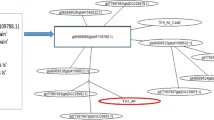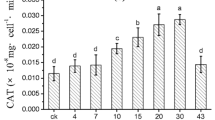Abstract
Ecklonia cava is a brown seaweed widely distributed on the coasts of Korea and Japan and is used as food ingredient, animal feed, fertilizer, and medicine. E. cava contains a variety of compounds including carotenoids, fucoidans, and phlorotannins that play diverse biological and ecological roles. The marine algal polyphenols, the phlorotannins, found only in the brown algae have greater potential antioxidant activity than the polyphenols from terrestrial plants. Considering their significance in industrial applications, it would be beneficial to develop a simple method that can enhance amounts of phlorotannins in such algae. By adding 2 μM methyl jasmonate (MeJA) to the postharvest culture for 24 h, the crude phlorotannin content was increased by 156 %. The contents of individual phlorotannins, such as dieckol, phlorotannin 974A, phlorotannin 974B, and phlorofucofuroeckol-A were also increased by approximately 224, 176, 227, and 181 %, respectively. Additionally, MeJA treatment significantly enhanced the viability of E. cava tissue, suggesting that MeJA may prevent postharvest decay, at least in the short term.





Similar content being viewed by others
References
Arnold TM, Targett NM, Tannar CE, Hatch WI, Ferrari KE (2001) Evidence for methyl jasmonate induced phlorotannin product in Fucus vesiculosus (Phaeophyceae). J Phycol 37:1026–1029
Bennett RN, Wallsgrove RM (1994) Secondary metabolites in plant defense mechanisms. New Phytol 127:617–633
Bouarab K, Adas F, Gaquerel E, Kloareg B, Salaun JP (2004) The innate immunity of a marine red alga involves oxylipins from both the eicosanoid and octadecanoid pathways. Plant Physiol 135:1838–1848
Chowdhury MTH, Bangoura I, Kang JY, Park NG, Ahn DH, Hong YK (2011) Distribution of phlorotannins in the brown alga Ecklonia cava and comparison of pretreatments for extraction. Fish Aquat Sci 14:198–204
Collen J, Herve C, Guisle-Marsollier I, Leger JJ, Boyen C (2006) Expression profiling of Chondrus crispus (Rhodophyta) after exposure to methyl jasmonate. J Exp Bot 57:3869–3881
Creeman RA, Mullet JE (1997) Biosynthesis and action of jasmonate in plants. Annu Rev Plant Physiol 48:355–381
Davis AR, Targett NM, McConnell OJ, Young CM (1989) Epibiosis of marine algae and benthic invertebrates: natural products chemistry and other mechanisms inhibiting settlement and overgrowth. Bioorg Mar Chem 3:85–114
Dixon RA, Pavia NL (1995) Stress-induced phenylpropanoid metabolism. Plant Cell 127:617–633
FDA (2013) U.S. Food and Drug Administration, Code of Federal Regulations 21, Part 182. http://www.fda.gov. Accessed 04 August 2014
Gaquerel E, Herve C, Labriere C, Boyen C, Potin P, Salaun JP (2007) Evidence for oxylipin synthesis and induction of a new polyunsaturated fatty acid hydroxylase activity in Chondrus crispus in response to methyljasominate. BBA-Mol Cell Biol 1771:565–575
Gharechahi J, Khalili M, Hasanloo T, Salekdeh GH (2013) An integrated proteomic approach to decipher the effect of methyl jasmonate elicitation on the proteome of Silybum marianum L. hairy roots. Plant Physiol Biochem 70:115–122
Guiry MD, Guiry GM (2014) AlgaeBase. World-wide Electronic Publication, National University of Ireland, Galway. http://www.algaebase.org. Accessed 03 April 2014
Heo SJ, Ko SC, Cha SH, Kang DH, Park HS, Choi YU, Jung WK, Jeon YJ (2009) Effects of phlorotannins isolated from Ecklonia cava on melanogenesis and their protective effects against photo-oxidation stress induced by UV-B radiation. Toxicol in Vitro 23:1123–1130
Karban R, Baldwin IT, Baxter KJ, Laue G, Felton GW (2000) Communication between plants: induced resistance in wild tobacco plants following clipping of neighboring sagebrush. Oncologia 125:66–71
Kim AR, Shin TS, Park JY, Park KE, Yoon NY, Kim JS, Choi JS, Jang BC, Byun DS, Park NK, Kim HR (2009) Isolation and identification of phlorotannins from Ecklonia stolonifera with anti-oxidant and anti-inflammatory properties. J Agric Food Chem 57:3483–3489
KN Pelletreau (2008) The application of molecular tools towards the study of brown algal chemical ecology and the production of phlorotannins. Dissertation, University of Delaware
Küpper F, Gaquerel E, Cosse A, Adas F, Peters AF, Müller DG, Kloarer B, Salaun JP, Potin P (2009) Free fatty acids and methyl jasmonate trigger defense reactions in Laminaria digitata. Plant Cell Physiol 50:789–800
Lee SH, Park MH, Heo SJ, Kang SM, Ko SC, Han JS, Jeon YJ (2010) Dieckol isolated from Ecklonia cava inhibits α-glucosidase and α-amylase in vitro and alleviates postprandial hyperglycemia in streptozotocin-induced diabetic mice. Food Chem Toxicol 48:2633–2637
Li Y, Lee SH, Le QT, Kim MM, Kim SK (2008) Anti-allergic effects of phlorotannins on histamine release via binding inhibition between IgE and FcεRI. J Agric Food Chem 56:12073–12080
Myung CS, Shin HC, Bao HY, Yeo SJ, Lee BH, Kang JS (2005) Improvement of memory by dieckol and phlorofucofuroeckol in ethanol treated mice: possible improvement of the inhibition of acetylcholinesterase. Arch Pharm Res 28:691–698
Nam BH, Jin HJ, Kim SK, Hong YK (1998) Quantitative viability of seaweed tissues assessed with 2,3,5-triphenyltetrazolium chloride. J Appl Phycol 10:31–36
Pavia H, Tooth G (2000) Inducible chemical resistance to herbivory in the brown seaweed Ascophyllum nodosum. Ecology 81:3212–3225
Provasoli L (1968) Media and prospects for cultivation of marine algae. In: Watanabe A, Hattori A (eds) Culture and Collections of Algae. Japan Soc Plant Physiol, Tokyo, pp 63–75
Radman R, Saez T, Bucke C, Keshavarz T (2003) Elicitation of plants and microbial cell systems. Biotechnol Appl Biochem 37:91–102
Ragan MA, Glombitza KW (1986) Phlorotannins: brown algal polyphenols. Prog Phycol Res 4:130–241
Ruiz-Medrano R, Cazares BX, Lucas W (2001) The phloem as a conduit for inter-organ communication. Curr Opin Plant Biol 4:2002–2009
Sák M, Dokupilová I, Mihálik D, Šajbidor (2013) Response of Vitis vinifera cell cultures on stress caused by methyl jasmonate. Curr Opin Biotech 24:S127
Schoenwaelder MEA, Clayton MN (1998) Secretion of phenolic substances into the zygote wall and cell plate in embryos of Hormosira and Acrocarpis (Fucales, Phaeophyceae). J Phycol 34:969–980
Singh G, Gavrieli J, Oakey JS, Curtis WR (1998) Interaction of methyl jasmonate, wounding and fungal elicitation during sesquiterpene induction in Hyoscyamus muticus in root cultures. Plant Cell Rep 17:391–395
Steinberg PD (1984) Algal chemical defense against herbivore: allocation of phenolic compounds in the kelp Alaria marginata. Science 223:405–406
Sun D, Lu X, Hu Y, Li W, Hong K, Mo Y, Cahill DM, Xie J (2013) Methyl jasmonate induced defense responses increase resistance to Fusarium oxysporum f. sp. cubense race 4 in banana. Sci Hortic 164:484–491
Targett NM, Arnold TM (1998) Predicting the effects of brown algal phlorotannins on marine herbivores in tropical and temperate oceans. J Phycol 34:195–205
Wang K, Jin P, Cao S, Shang H, Yang Z, Zheng Y (2009) Methyl jasmonate reduces decay and enhances antioxidant capacity in Chinese Bayberries. J Agric Food Chem 57:5809–5815
Waterman PG, Mole S (1994) Analysis of phenolic plant metabolites. Blackwell Scientific Publications, Oxford
Yoon NY, Chung HY, Kim HR, Choi JS (2008) Acetyl and butyrylcholinesterase inhibitory activities of sterols and phlorotannins from Ecklonia stolonifera. Fish Sci 74:200–207
Yotsu-Yamashita M, Kondo S, Segawa S, Lin YC, Toyohara H, Ito H, Konoki K, Cho Y, Uchida T (2013) Isolation and structural determination of two novel phlorotannins from the brown alga Ecklonia kurome Okamura, and their radical scavenging activities. Mar Drugs 11:165–183
Zhao J, Davis LC, Verpoorte R (2005) Elicitor signal transduction leading to protection of plant secondary metabolites. Biotechnol Adv 23:283–333
Acknowledgments
This work was supported by the National Research Foundation of Korea Grant funded by the Korean Government (MEST) (NRF-M1A5A1-2011-0029963).
Author information
Authors and Affiliations
Corresponding author
Rights and permissions
About this article
Cite this article
Chowdhury, M.T.H., Cho, JY., Ahn, DH. et al. Methyl jasmonate enhances phlorotannin production in the brown seaweed Ecklonia cava . J Appl Phycol 27, 1651–1656 (2015). https://doi.org/10.1007/s10811-014-0456-6
Received:
Revised:
Accepted:
Published:
Issue Date:
DOI: https://doi.org/10.1007/s10811-014-0456-6




